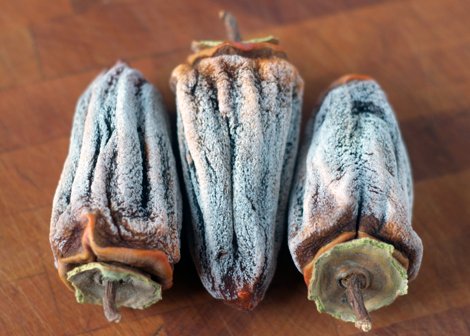Hoshigaki, realized
 They said it couldn't be done. Or maybe they said it shouldn't be done. Perhaps they said they had never done it. Whatever they said and whoever they are, I did it. Several weeks ago, I hung several peeled hachiya persimmons in our basement to dry. Through a process of hang-drying, combined with occasional gentle massaging, they evolved from firm, bright orange globes into squishy, wizened, burnt-siena sacs with a fine, white powder on the exterior. They became hoshigaki, the Japanese traditional dried persimmons.
They said it couldn't be done. Or maybe they said it shouldn't be done. Perhaps they said they had never done it. Whatever they said and whoever they are, I did it. Several weeks ago, I hung several peeled hachiya persimmons in our basement to dry. Through a process of hang-drying, combined with occasional gentle massaging, they evolved from firm, bright orange globes into squishy, wizened, burnt-siena sacs with a fine, white powder on the exterior. They became hoshigaki, the Japanese traditional dried persimmons.  There was uncertainty along the way, to be sure. Traditional methods have the persimmons hanging outside, with ample airflow and some exposure to sun. My basement is dark, with one sheltered window on the far end. It does, however, have decent airflow, as there's a grate that fronts out onto the sidewalk, and a moderately consistent humidity and temperature range. At first, the slippery surfaces of the persimmons became tacky, then leathery. Brown streaks began to appear on the flesh. I gently pinched them between my fingers until I felt the resistance begin to give Then, every few days, I would give them delicate massages. The flesh continued to darken and reduce. At each massage, the flesh would seem to have firmed up again, but would loosen under my fingers, yielding as if to a lover's touch. About a month after I hung the fruit, the first bloom of fine, white sugar began to appear on its surface.Somehow I managed to avoid the scourge of mold, ants, rodents or my dog ravaging my precious quarry. Not that the success rate was absolute; I hung a second batch a couple weeks after my first, and some of these had begun to ripen by the time I got them strung up. Among those, a few erupted during their massages. They still did not mold, but are aesthetically not as pleasing as the rest. Oh well, more for me.
There was uncertainty along the way, to be sure. Traditional methods have the persimmons hanging outside, with ample airflow and some exposure to sun. My basement is dark, with one sheltered window on the far end. It does, however, have decent airflow, as there's a grate that fronts out onto the sidewalk, and a moderately consistent humidity and temperature range. At first, the slippery surfaces of the persimmons became tacky, then leathery. Brown streaks began to appear on the flesh. I gently pinched them between my fingers until I felt the resistance begin to give Then, every few days, I would give them delicate massages. The flesh continued to darken and reduce. At each massage, the flesh would seem to have firmed up again, but would loosen under my fingers, yielding as if to a lover's touch. About a month after I hung the fruit, the first bloom of fine, white sugar began to appear on its surface.Somehow I managed to avoid the scourge of mold, ants, rodents or my dog ravaging my precious quarry. Not that the success rate was absolute; I hung a second batch a couple weeks after my first, and some of these had begun to ripen by the time I got them strung up. Among those, a few erupted during their massages. They still did not mold, but are aesthetically not as pleasing as the rest. Oh well, more for me.  I sampled one of my finished fruits. They had the dense, chewy texture and subtle sweetness I remember from ones procured from local farms, plus just a hint of tannic bitterness lingering on the back of the tongue. It took an ounce of self-restraint to keep from eating them all myself. But no, from the beginning the idea was for these to be gifts. I put them in cellophane bags, folded and tied at the top, to keep them from overdrying and becoming tough. And, of course, it makes them cute besides, especially with my fancy Punk Domestics tags (otherwise known as Moo cards). Best of all? Commercial hoshigaki retail at more than $2 per ounce. I paid $2.50 per pound for my fresh fruit.
I sampled one of my finished fruits. They had the dense, chewy texture and subtle sweetness I remember from ones procured from local farms, plus just a hint of tannic bitterness lingering on the back of the tongue. It took an ounce of self-restraint to keep from eating them all myself. But no, from the beginning the idea was for these to be gifts. I put them in cellophane bags, folded and tied at the top, to keep them from overdrying and becoming tough. And, of course, it makes them cute besides, especially with my fancy Punk Domestics tags (otherwise known as Moo cards). Best of all? Commercial hoshigaki retail at more than $2 per ounce. I paid $2.50 per pound for my fresh fruit. 

